Just discovered indoor bouldering and itching to try the real thing on rock? Not sure what to expect—or if you’re strong enough? Want to level up your skills and get the most out of this awesome sport? And seriously, why does it all look so easy when the pros do it?
Tip 1: Keep it simple with gear
Bouldering is all about minimalism, especially indoors. As a beginner, you don’t need much to start; just the basics will do.
Climbing Shoes
The one thing you really need to start bouldering indoors is a good pair of climbing shoes. Find a pair that fits you well—comfort and a snug fit are key. Don’t get distracted by the extreme shoes the pros wear; high-performance models won’t automatically make you climb better as a beginner.
Fun fact: there’s no real difference between climbing shoes and bouldering shoes, but many people go for models with features tailored to bouldering.
Chalk & Chalk Bag
Next up: chalk. A simple chalk bag filled with magnesia powder helps keep your hands dry and grip solid. You’ll also see extra-large versions—called boulder bags—that hold more chalk. For your first sessions, renting a bag is totally fine.
Brush
A climbing brush (with either natural or synthetic bristles) helps clean holds and boost friction. It’s a small tool, but it makes a big difference when the holds get dusty or slippery.
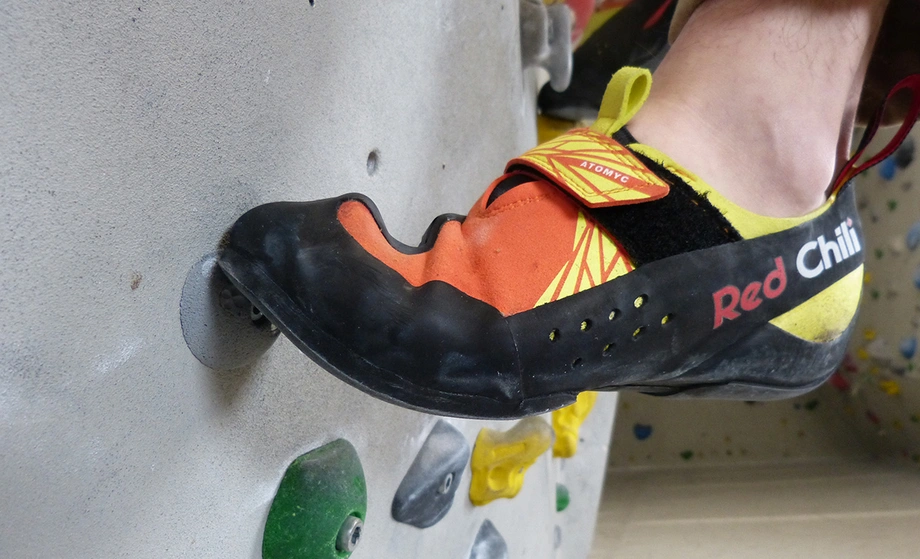
The proper footwear allows controlled edging and smearing on the most delicate foothoulds.
Many boulderers (even some bouldering gumbys) use finger tape. This, unless you are jamming, serves no purpose at all. Taping without actually injuring your fingers harms the tips because callus will not form. The growth of this skin is of vital importance for bouldering. So, please keep in mind: No prophylactic tape, and only use it if you are going to split a tip.
Tip 2: Get to know your bouldering style
More brain than brute: Sure, strength matters—but it’s only useful if it’s explicitly trained for climbing. Bouldering isn’t just the gym with rocks. Building bulky muscle that doesn’t translate into climbing movement can hold you back by weighing you down.
What really counts is learning how to “read” a route and move through it with control and technique. Bouldering is like solving a puzzle with your body. Beginners who focus on learning good movement first—and then building strength around that—tend to progress much faster.
Technique before strength. If you try to muscle your way through every problem, you’ll hit a wall (literally and figuratively). And pushing beyond your physical limits too soon can lead to injuries.
Tip 3: Stay safe!
The DAV (The German Alpine Club) has summarized the most essential measures you should keep in mind when starting up in the world of gym bouldering/climbing:
- Keep the fall area clear: Do not enter the mat area below the bouldering walls when someone is hanging on the wall. Unfortunately, many boulderers sit too close to the wall and do not look up when they go underneath. Serious collisions between climbers and the “ground crew” are not uncommon.
- “Spotting.” On higher-difficulty climbs it is recommended to stand below the boulderer with hands extended upward (at a safe distance) and “spot” the boulderer in the event of a fall, i.e., put the boulderer in a stable fall position. This will help prevent injuries during the fall (breaking an arm while attempting to catch your fall, etc.).
- Jumping off or downclimbing? For high balling (a boulder above 2.5 meters), it is recommended that you first climb down some holds and then jump back onto the mat.
- First, look down, then jump off. Check if people are in the fall zone before jumping off!
- Supervise children / watch out for children
Tip 4: Stay calm and boulder on
Patience is key to topping out.
Many boulder problems aren’t solved with one big, bold move. Instead, they require patient trial and error. Wild, desperate attempts usually lead to frustration. The best approach is to experiment with the movement sequence—tweak and practice it—before trying to link all the moves together in one go.
Also, don’t put too much pressure on yourself to perform perfectly. If you start feeling frustrated, remember this golden rule: patience pays off.
Tip 5: Get the sequence right!
Bouldering is as much mental as physical.
Even if you’re starting out and can’t move as smoothly or elegantly as the pros, you can begin training your eye to spot the best way to solve each problem.
Some boulders are easy to read—move your hands and feet like climbing a ladder. For those, trust your instincts and keep it steady.
But when you face problems that look like brain teasers from the ground, take your time. Break the moves down, experiment with different sequences, and don’t be afraid to get creative. Solving these puzzles is part of the fun and what helps you improve.
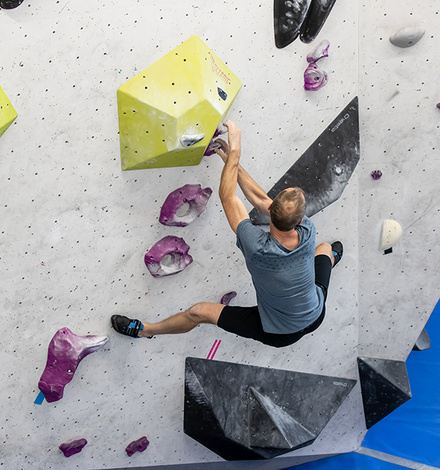
Not all bouldering follows for laddering. Often trial and error marks the path to success.
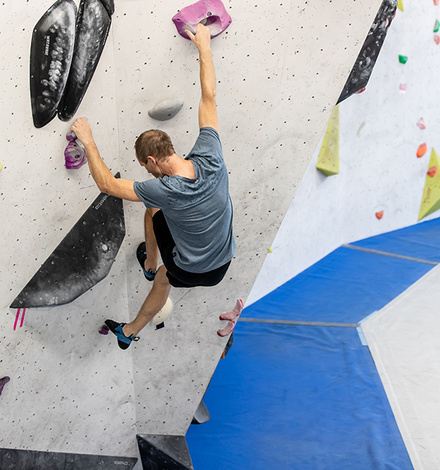
You may have to cross-step or cross-grip. Or you may have to shift your center of gravity several times before you can beat gravity.
Once you have found such a boulder, you are exactly where you should be as a beginner if you want your progression to begin. Begin your “trial and error” process: Try every possible solution! You can also watch an experienced boulderer solve your problem (probably frustratingly).
You should also remember that bouldering is a challenging sport where you have to or can go to the limits. Now and then, you must consider a very strenuous and initially seemingly impossible solution! Only by giving your all will you progress. Some boulders require hours of mental work until the long-awaited “breakthrough” occurs. The shortest route does not always have to be the easiest. For example, many bouldering routes require detours between holds, such as changing foot positions on a single hold several times and twisting your body to get to the next hold.
The shortest route is not always the easiest – sometimes you have to take detours between holds when bouldering.
My secret tip: Learning tricks while bouldering is the be-all and end-all! What I mean by that is that you have to learn not only to bear down and overcome the distances between holds by yanking at them, but also to develop your style. This style, in turn, allows you as a boulderer to turn any movement, no matter how difficult, into the flow-through technique, brains, and patience.
Tip 6: Climbing technique and effective movement
A common mistake when getting into the sport: The correct body position can be achieved by pulling with the arms, especially by using probably the most critical body part in bouldering – and climbing – in general: your hips!
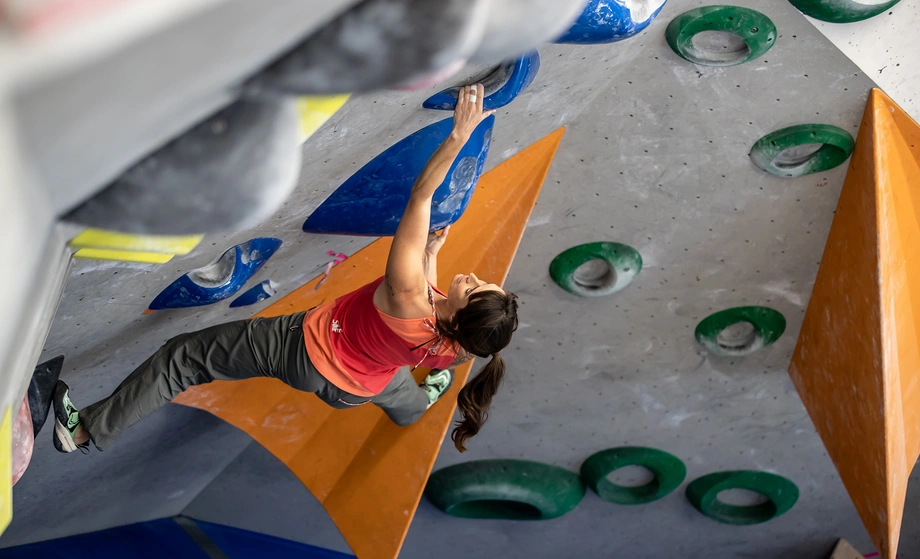
Not by pulling with the arm, but by the positioning of your hips (= body center of gravity) you will find success.
In fact, by turning your hips or taking momentum from them, you can control many movements in a specific direction and manage upward progress.
There are two simple ways to use the hips: first, when climbing in a frontal position (face facing the wall, legs stretched apart), and second, when climbing in a rotated position.
Tip 7: Stay in your lane
A typical frustration scenario in the climbing gym reads something like this: You have been trying your new bouldering project for some time (too long) without making any breakthroughs. An experienced boulderer comes around the corner (quite often, he/she is between 15 and 20 years old …) and does your boulder as a warm-up or as a throw-away between burns on their project. Oh – the joy!
Don’t let things like this frustrate you – take them as a chance to learn something from other climbers! The slightest change in your proposed solution will often be the ticket to success. Learn as much as possible from experienced boulderers. They frequently have automated movement patterns, moving instinctively without having to think. Determine the differences between your solution and that of an experienced boulderer and implement them yourself on the wall!
By the way, it doesn’t cost anything to ask. Even if the others are much better, they certainly don’t mind if you ask them for their expertise!
Tip 8: Get strong bouldering!
First, before you even think about cranking out the dumbbells or hitting the campus board, you should dedicate yourself to a technique first and foremost. In other words, you should develop an efficient climbing technique from your first visit to the gym. Now to “strength training”: As a bouldering beginner, it makes sense not to do additional strength training! If you think you don’t have enough strength to do a boulder, here’s some advice from years of experience: If you try one or more boulders for a longer period, whether successful or not, you automatically get an enormous increase in power, which can soon be converted into the desired success if you climb regularly.
If you want to get better and need more power, go bouldering! For now, leave all other additional training methods outside the bouldering gym!
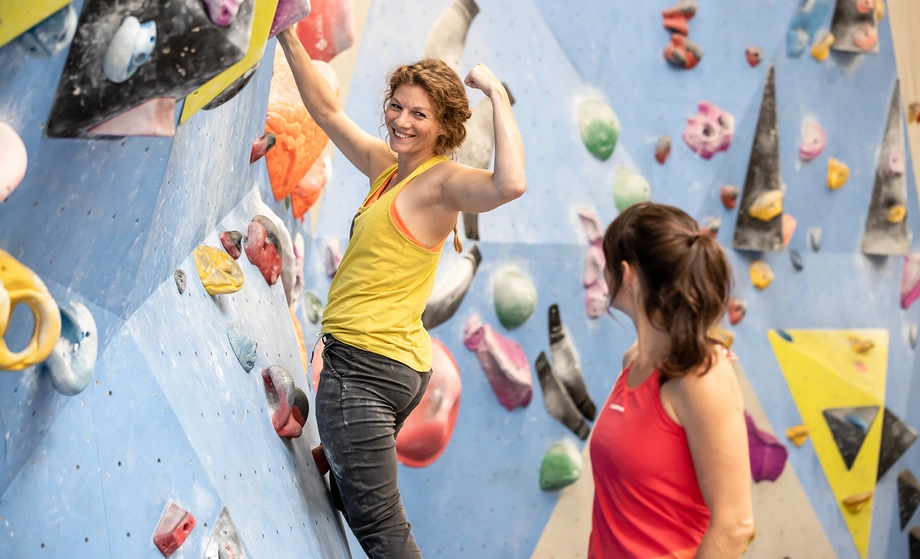
Bouldering beginners do not need any additional strength training. The muscle strength comes from bouldering.
You get bouldering strength from bouldering, power is of little help without good technique.
It’s silly to head to the gym if you’re unhappy with your bouldering strength. This will only undo all the specific bouldering power you have built up while bouldering! Pure training on machines may help World Cup boulderers build strength in particular areas, but not beginners.
They have already perfected the basic technique and power to such an extent that it is only a matter of fine-tuning their strength-specific deficits. Thick muscles not adapted to bouldering are nothing more than an extra weight that you have to hoist up the problem!
Remember that additional climbing training involves a risk of injury since you often do not know or cannot estimate your maximum load.
Tip 9: Don’t overdo it, and try not to get injured
More important here than the “how often” is the “how”: The typical injuries in bouldering affect the fingers, shoulders, and back. There are two different reasons for this: insufficient warm-up or wanton overloading of the body.
Physical damage from bouldering occurs when you push your body so far that, at some point, it can no longer muster enough strength and stability and is injured by so-called overload. So, you should never overdo a session. Accentuate with heavy sessions (e.g., every third time you go bouldering) and consolidate your technique and strength in between with moderate bouldering sessions where you don’t push your body max – please take it easy!
In general, you should warm up with easy bouldering and always do the hard bouldering at the beginning right after warming up! In a state of fatigue, the risk of injury increases significantly. At the end of your session, trying again on a boulder with small crimps, for example, is a bad idea.
Pulleys, tendons, or capsules on the fingers can tear, rip, or be overstretched. Depending on the intensity of the injury, healing can take up to a year and usually involves permanent chronic damage. Pulleys, ligaments, and capsules are injured mainly by excessive tears at small groins and slipping off small holds. Tendons can easily be overstretched or even torn if you pull too hard on finger pockets
You must always use small grips appropriately for your current strength level. There is a fine line between training effectively just at the limit and overtraining beyond your body’s tolerance.
Tip 10: Bouldering outdoors is a different ball game altogether
You have already collected some basic knowledge, technique, and strength for bouldering and would now like to test it all in the purest form of this sport, namely bouldering outside – on real rock. Then there are a few words of advice which may save you one or the other bad experience:
Indoor and outdoor bouldering is completely different. At the gym, the operator pays close attention to keeping the risk factors of this sport to a minimum. Outside, however, there are no soft bouldering mats, only crash pads (portable mats that you place under the boulder). Similarly, bouldering on rock often does not offer a flat fall zone; instead, one often has to contend with large stones or roots that must be expertly covered with the help of a crash pad.
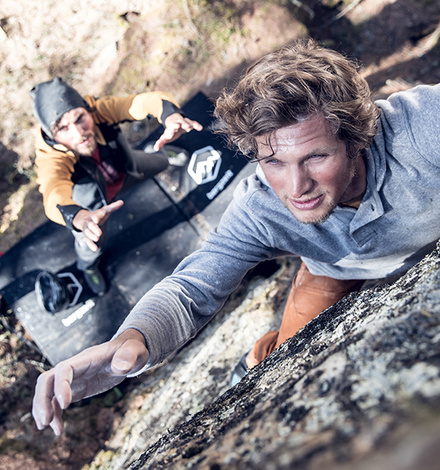
On the rock, there are no soft sports mats to cushion your fall – good spotting is then name of the game.
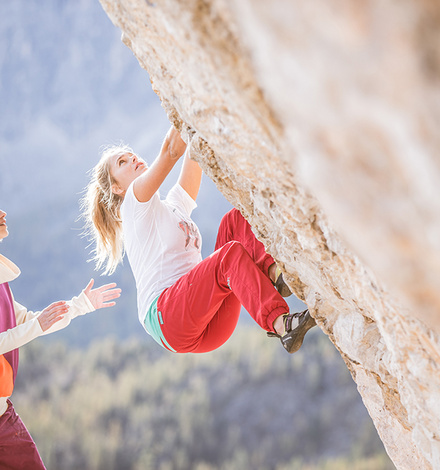
But bouldering on the rock offers its very own charm. Grab an experienced boulderer and get cranking outside!
Taking your first steps in outdoor bouldering with an experienced boulderer is best. The “spotting” (tip 3) mentioned in the safety measures is almost always indispensable on the rock! However, it requires some practice to reliably perform spotting in different and sometimes more serious scenarios. More alpine bouldering areas often have tricky fall zones that must be laid out with multiple crash pads and require a bomb-proof spotter. Areas like Fontainebleau in France offer sandy fall zones and are more suitable for beginners.
Last note when hitting the great outdoors:
- Hopefully, it will be obvious not to leave trash behind, light fires, or restrict bouldering areas out of respect for the landowners.
- In most indoor bouldering gyms, cheering loudly for each other, listening to music in the background, and having many people gathered in one place are part of the experience. Outside, however, noise such as shouting and music disturbs nature’s fauna—but that is only my opinion.